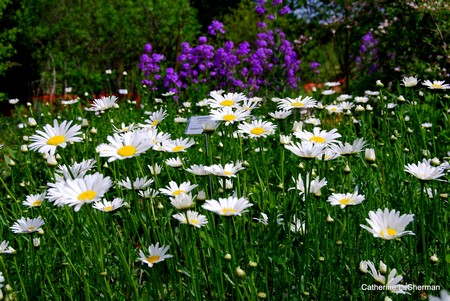Without a steady supply of fertilizers, starvation soon sets in — bringing weak growth, poor roots and lack of fruit and flowers. While nitrogen, phosphate and potassium are the chief foods for balanced growth, small amounts of iron, magnesium, boron, calcium, and other nutrients too numerous to mention, are also needed. However, these are normally present in sufficient amounts in any reasonably fertile soil. In the main it is nitrogen, phosphate and potassium which need supplementing. And one of the easiest ways to do this is to make regular routine applications of a balanced, complete general feed.
PLANNED FEEDING
Aim to view plant feeding in two stages. Initially give pre-planting or pre-sowing applications, and subsequently feed the growing plants.

Pre-sowing/planting dressings Rake dry applications of complete general fertilizer (like National Growmore) into the surface when preparing the ground for direct sowing, and similarly when preparing for setting out the likes of bedding, herbaceous and vegetable plants. A small handful per sqm (yd) makes an average dressing. For deeper rooting trees and shrubs, work the fertilizer into the bottom of the planting pockets and then infill around the roots with planting mixture or potting compost — both of which contain fertilizer.
Post-planting dressings
These are strongly recommended around all long-stay plants each spring. Work the feed lightly into the surface and water in. Always feed prior to mulching.
Dry feeds
It is normal to use a general complete fertilizer for applications to long-stay plants, but on occasions a potting compost containing fertilizer is a better bet. This is true in the case of shallow-rooting shrubs like rhododendrons, azaleas and camellias. In these instances be sure to opt for a lime-free mixture. A topdressing of potting compost is also worthwhile in the rock garden, to replenish soil washed down by winter rains. And for long-term plants being grown in containers, topdress with potting compost in the years they are not repotted. In this case scrape off the top 1 cm (V2 in) of old potting compost before applying the topdressing.
Liquid feeds give plants a quick, but short-lived boost. They are ideal as a back-up to dry spring feeds and are likely to be essential on light soils — and in high rainfall areas — where many plants can become starved before the end of the growing season. This is also true of container-grown plants and for these, too, liquid feeds are recommended. In the case of hungry fruiting or flowering crops, salads and greens, repeated, often weekly feeds are called for throughout the growing season. Select balanced high potash (potassium) feeds for all flowering and fruiting plants. Liquid feeds are easy to mix and use — follow the maker’s instructions.
Applying fertilizers Avoid exceeding recommended application rates – the risk is root scorch.
Avoid leaving pockets of high concentrations of fertilizer, as even distribution is essential.
Never apply feed to wilted or dried out plants; water first to avoid root damage.
Never use stale fertilizers as they can be harmful.
LIME AND LIMING
Why lime?
Lime has a big influence on soil fertility. In addition, the calcium supplied is an important plant food.
The most important effect of liming is to neutralize excessive soil acidity. An unduly acid soil restricts the work of beneficial bacteria and other soil life, and slows the breakdown of organic matter. Many plants find difficulty in taking up phosphate on very acid soils. Lime also has a direct beneficial effect on soil texture. Take heavy clay soils as an example. When limed, the tiny clay particles loosely unite to form larger crumbs, improving texture, drainage and aeration.
What to use
Lime is normally applied in the form of ground limestone. Initially the amount to apply can be ascertained by soil testing with a DIY kit. These kits come complete with instructions and are simple to use. Thereafter, a handful per sqm (yd), one year in three, should suffice. Clay and peaty soils can be limed more generously than others, say every two years.

How to lime
On vacant land, as on the unplanted vegetable plot, ideally scatter lime on the surface after digging in autumn or winter. But only lime a portion of the plot each year. Aim to rotate crops so that lime-loving members of the cabbage family are grown on the limed part in the first year, peas and beans in the second, and potatoes in the third, as the soil is reverting back to acid. In the case of fruits and permanently planted beds and borders, sprinkle lime around the plants in autumn and allow the rain to wash it in.
Guidelines for liming
- Lime if the soil is unduly acid.
- Lime when preparing the ground for lime-loving crops, like members of the cabbage family.
- Don’t lime if the soil is already chalky or limy. Excessively limy soil prevents plants from taking up boron, iron, magnesium and other nutrients needed for healthy growth.
- Don’t lime when growing lime-hating plants like rhododendrons, azaleas, heathers and potatoes.
- Don’t apply lime at the same time as fertilizers and manures, or you risk a chemical reaction and loss of nutrients. Allow a gap of 10 days or so.